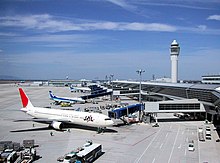Gate


Pier (sometimes also exit ), often English gate , describes the area at commercial airports through which passengers can get from the terminal building to the aircraft or directly into the aircraft after check-in and security control . The individual gates usually have a waiting area in front of them and are usually named with combinations of numbers and letters, for example gate / exit / gate B03 . Occasionally, the (parts of) buildings in which there are several exits are collectively referred to as a flight gate (then English concourse ).
There are now gates at some modern train stations - an example of this are all the stops on the China Railway high-speed trains. Passengers wait in halls that are separate from the platform and then - as at the airport - get to the train via a ticket lock shortly before departure .
procedure
After entering the respective terminal, passengers hand in their luggage at the check-in counter of their airline , presenting their personal documents and, if applicable, their flight tickets . You will then receive your boarding pass with your seat and gate number as well as proof of your checked baggage. The gates are equipped with or without security and ID checks, depending on their intended use. Passengers can in a waiting area at the gate waiting for their departure and on international flights duty free (Engl. Duty-free shopping). At the exit is after the call for boarding (dtsch. Boarding the aircraft ) control of boarding passes instead. This ensures that passengers and luggage are on the correct flight.
The passengers then get to the aircraft in three ways:
- If an aircraft is parked directly at the terminal building, it can be connected to the terminal with a movable arm ( passenger boarding bridge or finger for short ). Through this passage, the passengers get directly from the waiting area to their aircraft and vice versa after arrival from the aircraft to the arrival area or baggage claim . The finger is after parking by an operator by means of a hydraulic moves control to the front door of the aircraft. Larger airports also have several fingers at a boarding gate , which in the case of wide-body aircraft enable passengers to board the aircraft through several doors at the same time.
- In the second variant, the exit consists of simple doors that open towards the apron . Air passengers get through these doors to an apron bus that takes them to the aircraft. This prevents passengers from walking across the apron to their aircraft, which may be parked a few hundred meters from the terminal building. In this case, the passengers board the aircraft via the aircraft's own or approached stairs ( gangway ).
- At small airports and low-cost airlines in particular, it also happens that passengers walk from the gate on foot - usually via a closed path - to the aircraft. This saves the airline the fees for boarding bridges and buses.
